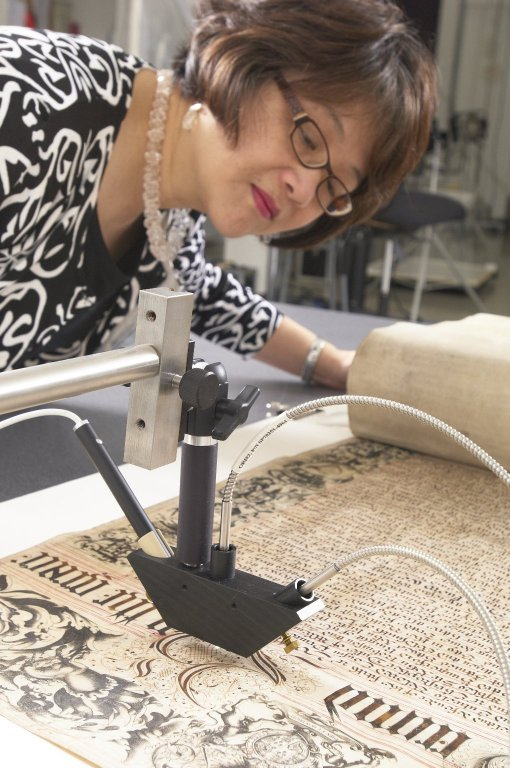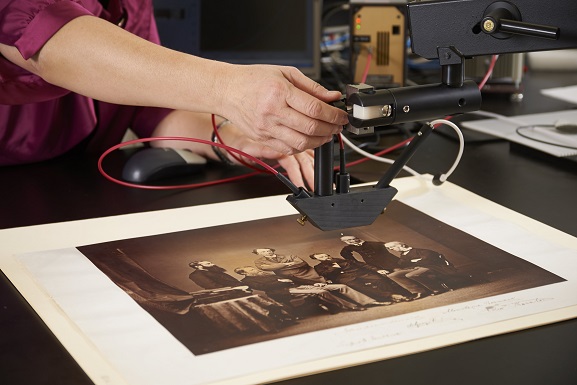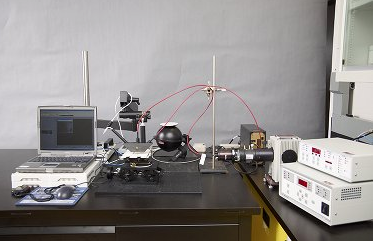Microfade testing services

Heritage professionals and institutions responsible for the conservation and safe display of objects and collections must deal with the dilemma of protecting them from exposure to light, particularly objects and collections suspected of being vulnerable to light damage. See the agent of deterioration, light, ultraviolet and infrared for more information on measuring light in a museum.
It is possible that light in a museum can cause permanent damage to some objects, leading to significant loss of aesthetic and historic values. The Canadian Conservation Institute's (CCI's) microfade testing helps heritage professionals and institutions identify objects that are at high risk of damage from exposure to light, such as watercolours, dyed textiles, documents written in modern pen inks, and botanical and insect specimens. The service provides data to support exhibition guidelines and lighting policies for the safe display of vulnerable objects in collections.
Microfade testing uses a highly sensitive technique for accelerated fading tests performed directly on an object or on minute samples from the object. It is quick and almost non–destructive. When the resulting data is used with the Light damage calculator, it is possible to visualize the future colour loss or colour change in objects as a result of various lighting scenarios. This information can then be used by institutions and collections managers to help determine whether or not to exhibit light–sensitive objects and, if so, under what type of lighting conditions.
CCI offers the microfade testing service at its laboratory in Ottawa (for objects or samples shipped to the Institute) or at a client's site, when shipping objects is not possible.
What is microfade testing?

Microfade testing is a highly sensitive and almost non–destructive technique that allows direct lightfastness testing on objects or minute samples from objects. Using a high intensity micro–spot of visible light, the tester illuminates and simultaneously measures the colour of the object, resulting in rapid and sensitive measurement of colour change during light exposure.
Since 2008, CCI has tested natural history collections, inks, pigments and paints on historically and nationally significant objects belonging to the Museum of Nature, Library and Archives Canada, the Library of Parliament and the Canadian Museum of History (formerly the Canadian Museum of Civilization). It is also being used for research in iron gall ink treatments, fading of dyes, inks and photographs, light bleaching of paper, and for screening loss–replacement materials used in treatments.
The microfading technique, first developed by Dr. Paul Whitmore at the Art Conservation Research Center, Carnegie Mellon University, Pittsburgh, helps museums, libraries and archives in the United States, Europe and Australia to identify objects that are highly susceptible to light damage. For risk assessment, this is a unique technique for “predicting” the extent and rate of light damage.
Service description

Microfade testing provides analysis of an object or a survey of collections in order to assist heritage professionals or institutions in assessing the lighting requirements for their display or storage.
The service is available to eligible clients in two ways:
- Analysis at the Canadian Conservation Institute
The object or samples from the object can be sent to CCI in Ottawa for artifact analysis and examination. - Analysis at a client's site
Where it is not feasible for the object to travel to CCI, if sampling is not possible, or if a survey of a collection is required, the portable microfade tester can be used at a client's site. To request the service, see on-site scientific services.
The microfade testing service provides lightfastness data for objects and collections of interest. It is an excellent opportunity for informal training of staff at a client's site on issues related to light damage, preventive conservation measures and conservation tools and resources. Access and knowledge of these resources will help heritage professionals make better lighting and exhibition decisions.
Clients requesting this service need to meet assessment of service requests. Additional requirements will be discussed with clients.
References
Learn more about microfade testing by consulting the following references. See Art&Archival for an up-to-date list of microfading references.
- Bannerman, Judith. "A New Tool for Collections Preservation: The Micro–fade Tester." REFLECTIONS on Conservation (2010), pp. 15–17.
- Morris, H.R., and P.M. Whitmore. "Virtual Fading of Art Objects: Simulating the Future Fading of Artifacts by Visualizing Micro–fading Test Results." Journal of the American Institute for Conservation 46 (2007), pp. 215–228.
- Tse, S., L. Cipera and C. Leckie. "Microfading to Support Exhibit Decisions." Collection Forum 25,1 (2011), pp. 92–106.
- Tse, S., S. Guild, V. Orlandini and M. Trojan–Bedynski. "Microfade Testing of 19th Century Iron Gall Inks." American Institute of Conservation 38th Annual Meeting in Milwaukee, WI: The Textile Specialty Group Postprints 20 (2010), pp. 167–180.
- Whitmore, P.M. "Pursuing the Fugitive: Direct Measurement of Light Sensitivity with Micro fading Tests." In H.K. Stratis and B. Salvesen, eds., The Broad Spectrum: The Art and Science of Conserving Colored Media on Paper. London, UK: Archetype Publications, 2002, pp. 241–243.
- Whitmore, P.M., C. Bailie and S.A. Connors. "Micro–fading Tests to Predict the Result of Exhibition: Progress and Prospects." In A. Roy and P. Smith, eds., Tradition and Innovation: Advances in Conservation. London, UK: International Institute for Conservation, 2000, pp. 200–205.
- Whitmore, P.M., X. Pan and C. Bailie. "Predicting the Fading of Objects: Identification of Fugitive Colorants Through Direct Nondestructive Lightfastness Measurements." Journal of the American Institute for Conservation 38 (1999), pp. 395–409.